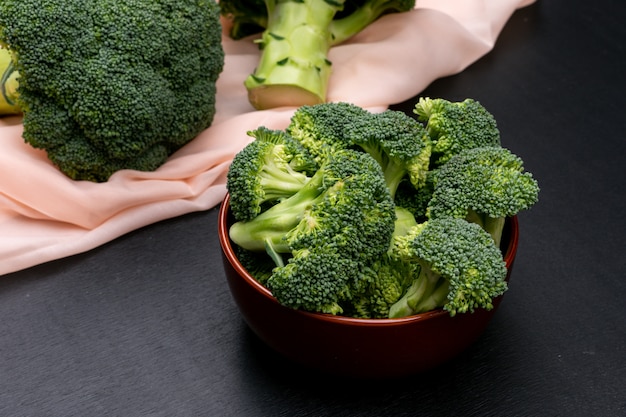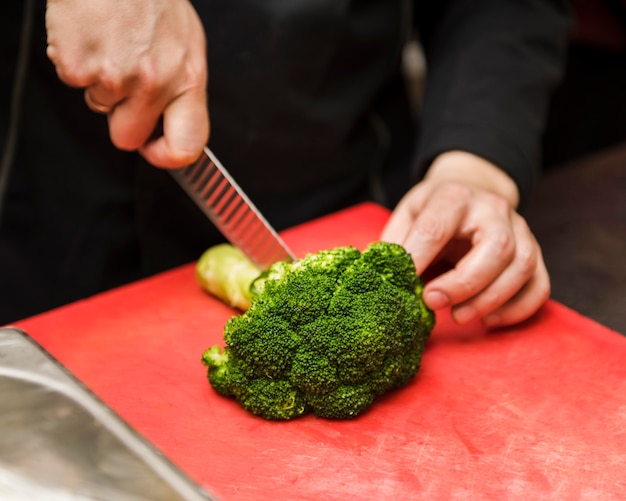Right, let's talk about gai lan, shall we? I'm not going to lie, this green, leafy wonder - also known as Chinese broccoli - was a bit of a mystery to me for a while. I always thought it was just another boring green vegetable. But then I discovered the magic of stir-frying it. The crunch, the flavour, the vibrant green colour - it's a total game-changer! And the best part? It's ridiculously easy to cook. Trust me, even if you're a complete newbie in the kitchen, you'll be whipping up delicious gai lan in no time. So grab your wok, your trusty spatula, and let's get cooking!
(Part 1) The Gai Lan Lowdown

Let's start with the basics. Gai lan, which translates to "happy vegetable," is a member of the Brassica family, a close relative of broccoli and kale. It's a bit of a showstopper, though. It's got these gorgeous dark green leaves, with thick, tender stalks that hold their own in any dish. You'll find it in most Asian supermarkets, sometimes labelled as Chinese broccoli or Chinese kale. And let's not forget the flavour! Gai lan has a unique, slightly bitter taste with a touch of sweetness - a perfect contrast to the richness of stir-fried meats or seafood.
Why Gai Lan is a Kitchen Hero
Beyond its flavour and versatility, gai lan is a nutritional powerhouse. It's packed with vitamins A, C, and K, plus a good dose of calcium and fiber. So, you're not just getting a delicious dish, you're also getting a healthy dose of goodness.
Choosing the Perfect Gai Lan
The key to a delicious gai lan dish is, of course, starting with the best ingredients. When choosing your gai lan, look for:
- Freshness: Look for bright green leaves with no wilting or yellowing. The stalks should be firm and crisp. You want those leaves to be perky and ready to shine!
- Size: Choose stalks that are about the thickness of your thumb. They're easier to work with and will cook evenly. You don't want to be wrestling with giant stalks or tiny, fragile ones.
- No Pests: Give those leaves a good look over. Make sure there aren't any signs of bugs or other unwanted guests. It's always a bummer to find a little critter hiding in your veggies, right?
(Part 2) Getting Down to Business: Preparing Your Gai Lan

Once you've got your perfect bunch of gai lan, it's time to get your hands dirty (literally!). Don't worry, it's a pretty simple process, and you'll be a gai lan pro in no time.
Washing and Trimming
First things first, give that gai lan a good wash. I usually give it a quick soak in a bowl of cold water, then rinse it thoroughly under running water. This gets rid of any dirt or debris and ensures that your gai lan is nice and clean. Next, grab a sharp knife and trim the tough ends of the stalks. You can also chop the stalks into smaller pieces if you prefer, which makes them cook faster. I find that chopping them into bite-sized pieces makes them easier to eat and cook more evenly.
The Secret to Tender Gai Lan: Blanching
Now, this is where things get interesting. Blanching, which is basically giving your gai lan a quick bath in boiling water, is the key to getting that perfectly tender texture. It helps to soften the stalks without overcooking the leaves. Think of it like a quick spa treatment for your gai lan, leaving it refreshed and ready for the next step. Here's how you do it:
- Bring a pot of water to a rolling boil: Make sure there's enough water to cover the gai lan completely. You want to make sure it's all submerged.
- Add a pinch of salt: This will help to bring out the flavour of the gai lan and give it a little extra punch. A little salt goes a long way!
- Carefully add the gai lan to the boiling water: Give it a gentle stir to make sure all the pieces are submerged. Don't toss it in there like a wild beast! You want to be gentle.
- Blanch for about 30 seconds: Don't overcook it! You want the stalks to be tender but still have a slight bite. It's all about that perfect balance, you know?
- Drain immediately: Transfer the gai lan to a colander and rinse with cold water to stop the cooking process. This will prevent it from overcooking and becoming mushy.
That's it! Now, your gai lan is ready for the next exciting step: stir-frying!
(Part 3) Stir-Frying Magic: The Perfect Gai Lan Recipe

You're ready for the grand finale, my friend. Stir-frying, the art of whipping up deliciousness in a matter of minutes. You'll need a wok, a trusty spatula, and a few essential ingredients:
Ingredients
- 1 pound gai lan, blanched (We already took care of this step!)
- 2 tablespoons oil (I prefer a neutral oil like vegetable oil, but you can use your favourite. Just make sure it has a high smoke point.)
- 2 cloves garlic, minced (Freshly minced garlic is always best! It adds a wonderful flavour.)
- 1/2 teaspoon salt (You can adjust this to your taste, of course.)
- 1/4 teaspoon black pepper (Freshly ground pepper is ideal, but pre-ground will do in a pinch.)
- 1/4 cup water (This helps create a delicious sauce and steam the gai lan.)
Instructions
Ready? Let's do this:
- Heat your wok over high heat: You want it nice and hot. I always give it a few minutes to warm up properly. A hot wok is essential for good stir-frying!
- Add the oil: Let it shimmer for a few seconds. You want the oil to be hot enough to sizzle when you add the garlic.
- Add the garlic: Stir-fry for about 15 seconds, just until fragrant. Don't let it burn! It should be golden brown and smell heavenly.
- Add the blanched gai lan: Give it a good toss to coat it in the oil and garlic. Get it all mixed up!
- Season with salt and pepper: Adjust to your taste. Remember, a little goes a long way!
- Add the water: This will help to steam the gai lan and create a delicious sauce. You'll see it start to bubble and sizzle.
- Stir-fry for 2-3 minutes: You want the gai lan to be tender and slightly wilted. It should still have a little crunch to it.
- Serve immediately: Enjoy with your favourite stir-fry companion, like rice, noodles, or even tofu. It's delicious all on its own too!
(Part 4) Flavour Booster: Spice It Up
Let's be honest, sometimes plain old stir-fried gai lan just isn't enough. It needs a little something extra, a touch of flavour magic. That's where the fun part comes in! You can experiment with different sauces, spices, and even other ingredients to create your own delicious variations. Let your creativity run wild!
Sauce Inspiration: A World of Flavours
If you're looking for a flavour boost, adding a little sauce can make all the difference. Try these options:
- Oyster Sauce: A classic choice for a rich, umami flavour. A tablespoon or two is all you need. It adds a savory depth and a touch of sweetness.
- Soy Sauce: Another favourite. Use a combination of light and dark soy sauce for a deeper, more complex flavour. Light soy sauce adds a salty punch, while dark soy sauce adds a deeper, richer flavor.
- Fish Sauce: This adds a savoury, slightly salty taste. Use sparingly, as it can be quite potent. A little goes a long way with this one.
- Hoisin Sauce: For a sweet and savoury kick, hoisin sauce is a perfect addition. It's a sweet and salty sauce with a unique texture that adds a layer of complexity to your gai lan.
Spice It Up: Add a Kick
Feeling adventurous? Why not add some heat? You can use:
- Red Pepper Flakes: A small pinch will give a gentle warmth. Start with a little and add more to your liking.
- Chili Peppers: Fresh or dried, chopped or sliced - the choice is yours. Red pepper flakes add a subtle heat, while chili peppers can provide a fiery kick.
- Chili Oil: A quick way to add a spicy kick. Just a few drops will do the trick. This adds a smoky flavour and a touch of heat.
Beyond the Basics: Exploring Flavour Combinations
The beauty of gai lan is its versatility. Don't be afraid to experiment. Try these combinations for a flavour explosion:
- Gai Lan with Shrimp and Garlic: A classic combination. The sweetness of the shrimp complements the bitterness of the gai lan perfectly. Add a squeeze of lemon juice for a bright touch.
- Spicy Gai Lan with Ground Pork: Add some chili peppers and a touch of Sichuan peppercorns for a fiery kick. A splash of Shaoxing wine adds a savory depth.
- Gai Lan with Tofu and Ginger: A simple, healthy option that's packed with flavour. Use fresh ginger for a sharper taste. Add a touch of sesame oil for a nutty aroma.
- Gai Lan with Chicken and Oyster Sauce: A satisfying combination with a rich, savory sauce. Add a touch of cornstarch to thicken the sauce for extra deliciousness.
Remember, cooking is all about having fun. Get creative, try different things, and find what works best for you. The possibilities are endless!
(Part 5) Serving Suggestions: Gai Lan on the Plate
You've got your delicious stir-fried gai lan. Now, what's the best way to showcase it? Here are a few ideas:
The Classic: A Simple and Elegant Presentation
For a simple yet elegant presentation, serve the gai lan on a plate or in a bowl. You can top it with a few toasted sesame seeds or a drizzle of sesame oil for a touch of sophistication. A sprinkle of chopped spring onions adds a bright, fresh element.
A Feast for the Eyes: Gai Lan as Part of a Larger Dish
Don't be afraid to combine your gai lan with other delicious ingredients. You can serve it alongside:
- Rice: A classic pairing, perfect for soaking up the delicious sauce. white rice, brown rice, or even fried rice work well.
- Noodles: Choose your favourite, whether it's thin rice noodles, thick udon noodles, or even spaghetti. Gai lan adds a burst of colour and flavour to any noodle dish.
- Tofu: A protein-packed option that complements the flavour of the gai lan. Try firm tofu, pan-fried or baked until golden brown.
- Seafood: Shrimp, prawns, fish - they all work beautifully with the gai lan. The combination of seafood and gai lan is a match made in heaven.
- Meat: Chicken, beef, or pork can be added to your stir-fry for a hearty meal. You can use pre-cooked meat or cook it alongside the gai lan.
(Part 6) Storage and Leftovers: Making the Most of Your Gai Lan
Let's be honest, sometimes you end up with a bit of leftover gai lan. Don't let it go to waste! Here's what you can do:
Storage Tips: Keeping Your Gai Lan Fresh
To keep your gai lan fresh for a day or two, store it in a plastic bag in the refrigerator. You can also wrap it in a damp paper towel before storing it. This will help to retain its moisture and prevent it from wilting.
Leftovers, Don't Worry: Creative Uses for Gai Lan
Leftover gai lan is a blank canvas for culinary creativity. Here are a few ideas:
- Gai Lan Fried Rice: Stir-fry your leftover gai lan with rice, eggs, and your favourite seasonings for a delicious meal. Add some soy sauce, garlic, and a sprinkle of sesame oil for extra flavour.
- Gai Lan Soup: Add it to a pot of broth for a hearty and healthy soup. You can use chicken broth, vegetable broth, or even a miso broth.
- Gai Lan Stir-Fry with Other Vegetables: Combine it with other vegetables like carrots, peppers, and onions for a colourful and nutritious dish. Add a touch of ginger and garlic for extra flavour.
- Gai Lan Noodle Salad: Toss your leftover gai lan with cold noodles, a tangy dressing, and chopped vegetables for a refreshing salad. Try a sesame dressing or a peanut sauce.
(Part 7) Beyond the Basics: Exploring Gai Lan Varieties
You know the standard gai lan, but did you know there are different varieties? Let's explore a few:
Gai Lan Variants: A World of Choices
Each of these varieties has its own unique flavour and texture. Don't be afraid to experiment with different varieties to find your favourites.
- Yu Choy: Also known as Chinese mustard greens, yu choy has a milder flavour than standard gai lan. It's often used in soups and stir-fries.
- Kai-lan: This variety has a slightly sweeter taste and more tender leaves. It's a popular choice for stir-frying.
- Choy Sum: With its distinctive, long, thin stalks, choy sum has a peppery flavour and a slightly firmer texture. It's often served with a garlic sauce.
- Tatsoi: Known for its distinctive, spoon-shaped leaves, tatsoi has a milder flavor than gai lan and a slightly sweeter taste. It's often used in salads and stir-fries.
(Part 8) FAQs: Your Gai Lan Questions Answered
What is the difference between gai lan and Chinese broccoli?
Gai lan and Chinese broccoli are essentially the same thing. The terms are often used interchangeably, but "gai lan" is the more accurate term. It's like calling a tomato a "love apple." The name might be different, but it's still the same delicious veggie.
Is gai lan a good source of nutrients?
Absolutely! Gai lan is packed with vitamins and minerals. It's a good source of vitamin A, vitamin C, vitamin K, and calcium. It's also a good source of fiber, which helps with digestion. It's a true nutritional powerhouse, packed with good stuff!
How do I know if gai lan is bad?
Look for signs of wilting, yellowing, or browning. If the stalks are soft or mushy, it's best to avoid it. Fresh gai lan should be crisp and vibrant.
Can I eat the leaves and stalks?
Yes! Both the leaves and stalks are edible. You can chop the stalks into smaller pieces, or eat them whole if you prefer. The stalks are actually a delicious part of the gai lan, full of flavour and texture.
Can I freeze gai lan?
You can freeze gai lan, but the texture may change slightly. It's best to blanch it first before freezing. This will help to preserve its colour and texture.
There you have it, a complete guide to the wonderful world of gai lan. Now go forth and cook! You've got this. And remember, have fun with it! Experiment with different flavours and techniques, and find what works best for you. Happy cooking!
Everyone is watching

Prime Rib Roast Cooking Time Chart: Per Pound Guide
Cooking TipsPrime rib roast. Just the name conjures images of lavish dinners, crackling fires, and hearty laughter. It’s ...

How Long to Bake Potatoes in the Oven (Perfect Every Time)
Cooking TipsBaked potatoes are a staple in my kitchen. They're incredibly versatile, delicious, and surprisingly easy to m...

Perfect Rice Every Time: The Ultimate Guide to Cooking Rice
Cooking TipsAs a self-proclaimed foodie, I've always been a bit obsessed with rice. It's the foundation of countless cuisi...

The Ultimate Guide to Cooking Asparagus: Tips, Techniques, and Recipes
Cooking TipsAsparagus. The mere mention of this spring delicacy conjures up images of vibrant green spears, crisp and burs...

Ultimate Guide to Cooking the Perfect Thanksgiving Turkey
Cooking TipsThanksgiving. Just the word conjures up images of overflowing tables laden with delicious food, the scent of r...
